





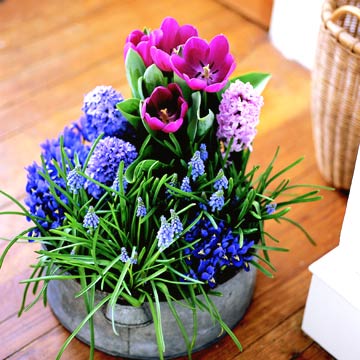 Tulips, hyacinth, grapehyacinth, and Iris reticulata
Tulips, hyacinth, grapehyacinth, and Iris reticulata
Springtime comes early when you force bulbs into bloom indoors. During the frigid, dreary months of winter, you'll enjoy the powerful fragrance of hyacinths, the sweet scent of paperwhite narcissus, and the cheerful color of tulips, as well as other spring-flowering bulbs, if you plan ahead.
Although it's not hard to fool Mother Nature, you can't hurry the process. Forcing most spring bulbs into bloom requires eight to 15 weeks of chilling, though there are varieties that can be ready for prime time in just two to three weeks.
Learn more about gardening with beautiful bulbs such as fritillaria.
continue reading belowWhen chilling bulbs in the refrigerator, store them away from fresh fruits and vegetables that can emit ethylene gas and damage the flowers developing inside the bulbs. Chill potted and bulk bulbs in closed paper bags.
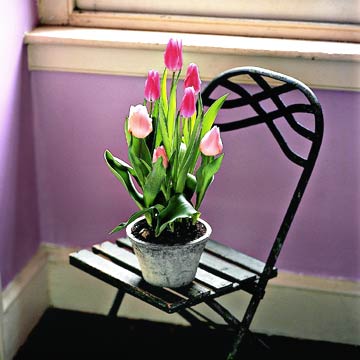 'White Cascade' and 'Wonderful'
tulips.
'White Cascade' and 'Wonderful'
tulips.
Unless they are marked as "prechilled," most flowering bulbs require a period of 35-45 degrees F. order to root and flower. (This simulated winter is not required for amaryllis or paperwhites, which can be potted up according to package directions, watered, and set out in a bright spot.) The length of time needed for chilling varies by type; see the chart at the end of this article.
In general, smaller bulbs like crocus, grape hyacinths, miniature daffodils, iris, and tulips are easy to force. Large, fragrant hyacinths are also easy. Whatever type of flower you decide to force, buy the largest size bulbs you can find. The bigger the bulb, the more flowers. Also, be sure the bulbs are firm, free from nicks and bruises, and that the roots haven't sprouted yet.
If the weather is still warm when you want to begin, you can store the bulbs in a mesh bag in the refrigerator for two to three weeks. Keep the bulbs in a vegetable bin, away from apples and other ripening fruit that can damage the bulbs. Even with this chilling period, the bulbs will still need to spend time chilling in a pot so they can develop their root system.
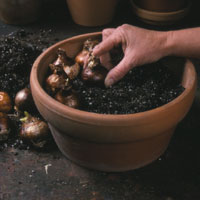 Step 2
Step 2
Most bulbs will do well if grown in potting mix. Always start with clean pots and fresh mix.
1. Plan ahead. In autumn, purchase bulbs from a garden center, nursery, or mail-order source. Plant bulbs of your choice in any type of pot with a drainage hole. Choose a pot that's at least twice as deep as the bulbs to allow for proper root growth. Fill the pot half full of soilless potting mix.
2. Place as many bulbs as possible in the pot, without letting them touch. A 6-inch-wide pot holds up to six tulips, three narcissus (daffodils), or 15 minor bulbs, such as crocuses or grape hyacinths.
For a thick show, layer more than one kind of bulb in the same pot; place larger bulbs on the bottom and they'll grow around the smaller ones. If the two bulbs you want to combine have different chilling and blooming schedules, plant them first in small plastic containers and combine them once they're in bloom.
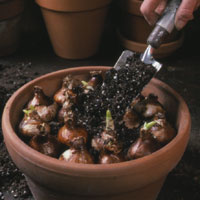 Step 3
Step 3
3. Cover the bulbs with potting mix, leaving their tips showing. Water the bulbs thoroughly. Label with name and date; loosely cover pot with a paper bag. Place in cool (35 to 45 degrees F), dark storage for chilling. See our bulb-forcing timetable for chilling time.
An unheated attic, basement, or attached garage makes a good chilling area, but monitor the temperature if the weather turns extremely cold. Another option is to set the pots outside in a 12-inch-deep trench, lined with pebbles to prevent the pots from freezing to the bottom. Cover the pots with 10 to 12 inches of soil, then 12 inches of dry leaves held in place with a plastic tarp.
4. Check moisture in pot periodically. Keep soil damp but not wet. When chilling is complete, you'll see roots poking out of the bottom of the pot and green sprouts emerging at the bulb tips. It's time to move the potted bulbs into a warm room.
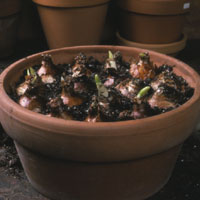 Step 5
Step 5
5. When flower buds form, move potted bulbs into a sunny spot. Keep the soil damp. When flowers appear, move the pot out of direct sun to make the blooms last longer. After the blooms fade and wither, toss them (bulbs and all) into the compost. Most forced bulbs have used up their energy and won't bloom again.
Paperwhites and Soleil d'Or can be grown without soil. Plant them in pebble-filled containers with the base of the bulbs in contact with water at the bottom of the container. These bulbs don't need chilling, but will benefit from a cool temperature (50 degrees F.) until the top shoot is a couple of inches long. At that point, you can move the plant into a warm, brightly lit area.
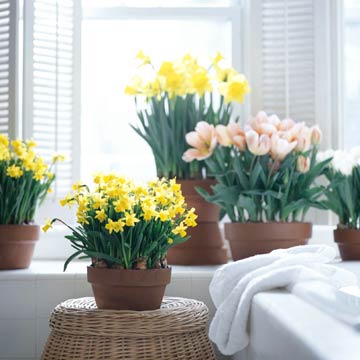 'Tete-a-tete' and 'Dutch Master'
daffodils with 'Apricot Beauty'
tulips.
'Tete-a-tete' and 'Dutch Master'
daffodils with 'Apricot Beauty'
tulips.
The needed chilling period is usually stated as a range. Begin checking the pots at the short end of the range; the pots can be moved to a warm spot once the shoots are 2-3 inches above the bulb.
As a very general rule, plan to start chilling bulbs in September for January bloom, October for February bloom, November for March bloom, and December for April bloom. For more specific timing, see the list below.
Copyright © www.100flowers.win Botanic Garden All Rights Reserved